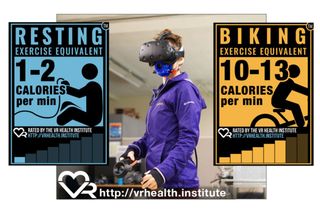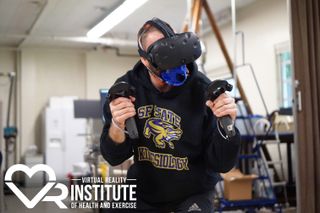VR Health Institute Develops VR Exercise Rating System

The VR Health Institute developed a rating system called the VR Exercise Rating that compares the calorie burn of VR games to common exercise activities such as walking, running, and swimming. It should come as no surprise that room-scale VR experiences can burn calories, but you may be surprised by how much exercise can you really get from playing a VR game.

The VR Health Institute partnered with the San Francisco State University’s Department of Kinesiology to measure the oxygen consumption of 40 test subjects while they played a variety of games to determine the how many calories the average person would burn in one minute of gameplay. The results were surprising.
“Many of the games we’ve assessed have turned out to be the equivalent of very vigorous exercise,” said Dr. Marialice Kern, lead VR researcher and the Chair of the Kinesiology department at San Francisco State University. “At the same time, we’ve observed that participants often don’t realize how much effort they’re actually exerting. They’re expending energy with less awareness of the pain of doing it.”
Dr. Kern’s observations are interesting, and they suggest that we could see a future where gamers are more fit than they’ve ever been before. Playing video games is traditionally a sedentary activity, and many people spend several hours every day playing their favorites games. In 2014, Nielson published a report that suggested that the average gamer spends 5.6 hours per week playing games. As VR gains more popularity, more and more gamers will, at least occasionally, get up and start moving around.
Dr. Kern’s observations also suggest that VR could have a positive impact on fitness engagement in general. Physical activity is paramount for a healthy lifestyle, but going to the gym can be a chore for many people. If you can get the same amount of exercise while playing a VR game at home that you can from using the equipment at your local gym, why would you go to the gym?

The VR Health Institute’s VR Exercise Rating features eight levels that represent different workout intensities that you can compare to, including Resting, Walking, Elliptical, Tennis, Rowing, Biking, Swimming, and Sprinting. Games with the Resting rating don’t offer physical activity and would burn less than three calories per minute. Games with the Tennis rating offer a brisk workout, with 6-8 calories burned per minute. And you can expect a significant workout with more than 15 calories burned per minute from games with the Sprinting rating.
“I believe that virtual reality is going to change what it means to go to the gym,” said Aaron Stanton, director and founder of the VR Health Institute. “Our goal is to help quantify which games may be the most useful as part of a healthy lifestyle. For those of us that simply suck at traditional exercise, like me, the diversity and engagement of VR is a game changer. I now believe that I will live longer and be fitter because I’m a gamer, not in spite it.”
Stay on the Cutting Edge
Join the experts who read Tom's Hardware for the inside track on enthusiast PC tech news — and have for over 25 years. We'll send breaking news and in-depth reviews of CPUs, GPUs, AI, maker hardware and more straight to your inbox.
The VR Health Institute and San Francisco State University have tested 25 games so far, including Space Pirate Trainer (Elliptical), Tilt Brush (Walking), Audioshield (Biking), and Thrill of the Fight (Sprinting). If you're a developer and you wish to have a rating for your game, you can submit your game for testing. The VR Institute said that it’s not necessary for developers to submit games, though, as it's actively looking for titles to include. Submitting a game may accelerate the process, though.
You can read more about the VR Institute and the VR Exercise Rating at the VR Health Institute's website.
Kevin Carbotte is a contributing writer for Tom's Hardware who primarily covers VR and AR hardware. He has been writing for us for more than four years.
-
Jeff Fx “Many of the games we’ve assessed have turned out to be the equivalent of very vigorous exercise,”Reply
I think they probably knew this before they even started the study. When you're breathing heavily, and soaked with sweat at the end of a game, you've been exercising just as much as you've been gaming. I have 5 fans in my VR room to keep me cool, and still wind up sweaty.
It was easy to justify the cost of a Vive because it's an exercise device just as much as it's an entertainment device. Playing co-op games with a friend pushes me harder than I would exercise on my own, and results in a great workout.
Just be aware that you have to keep the sweat under control. Sweat in your headset will destroy it, and will not be covered by warranty. Use a lot of fans like I do, or at least a sweatband.
Most Popular







